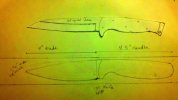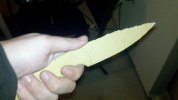- Joined
- May 23, 2011
- Messages
- 139
For the last couple of months I have been kicking around the idea of making my own knife. In fact, the idea is like a really bad itch that I have just not been able to get rid of. So I am going to start it.
I've been through the stickies and I've done a bunch of lurking here with the occasional question thrown out so I think that I am ready to start. I've also bought and read "50 Dollar Knife Shop," paying special attention to the stock removal sections. I also got another book, called something like "10 Knife-making projects" that went over everything from a first knife, "Paring Knife" all the way up to more advanced things like making a slipjoint folder.
As far as tools go, what I have is the following:
1. Craftsman 3-speed Drill Press
2. Hand Drill
3. 3-piece Craftsman File Set (Coarse)
4. C-Clamps, no table vise yet
5. Hacksaw
6. Sandpaper
7. Work Bench
8. Full Face Lexan Shield
9. DMT Diamond Hone Set (3-piece Coarse, Fine, Extra-Fine)
10. 2.5 Foot length of 1.5 in. wide O1 tool Steel 1/8 in. thick
I've been doing some drawings that last couple of days and here is what I have come up with.

The one on top is the first one I drew that I really really liked. But when I did a cardboard cutout the handle was a little small for my liking. So I went back to the sketch pad and used that as a base with what I had learned to draw up another. I extended the handle and made the belly of the handle less pronounced. I also gave the blade a bit more belly since when I elongated the first one, the blade took on too much of a Wharnecliff shape. I like Wharnecliff blades, but here I wanted something that would be more useful as an overall utility/camp knife. I also got rid of the exposed area of the tang because I figured that it would make it much more difficult in shaping the handles during finishing. I'll probably revisit this design if I continue making blades.
I'm going to do a cardboard cutout of the new design today to see how it feels in the hand. I'll post later to show it and give my thoughts.
So feel free to tell me what you guys think. And thanks in advance. I can't say it enough, but you guys are really great.
I've been through the stickies and I've done a bunch of lurking here with the occasional question thrown out so I think that I am ready to start. I've also bought and read "50 Dollar Knife Shop," paying special attention to the stock removal sections. I also got another book, called something like "10 Knife-making projects" that went over everything from a first knife, "Paring Knife" all the way up to more advanced things like making a slipjoint folder.
As far as tools go, what I have is the following:
1. Craftsman 3-speed Drill Press
2. Hand Drill
3. 3-piece Craftsman File Set (Coarse)
4. C-Clamps, no table vise yet
5. Hacksaw
6. Sandpaper
7. Work Bench
8. Full Face Lexan Shield
9. DMT Diamond Hone Set (3-piece Coarse, Fine, Extra-Fine)
10. 2.5 Foot length of 1.5 in. wide O1 tool Steel 1/8 in. thick
I've been doing some drawings that last couple of days and here is what I have come up with.

The one on top is the first one I drew that I really really liked. But when I did a cardboard cutout the handle was a little small for my liking. So I went back to the sketch pad and used that as a base with what I had learned to draw up another. I extended the handle and made the belly of the handle less pronounced. I also gave the blade a bit more belly since when I elongated the first one, the blade took on too much of a Wharnecliff shape. I like Wharnecliff blades, but here I wanted something that would be more useful as an overall utility/camp knife. I also got rid of the exposed area of the tang because I figured that it would make it much more difficult in shaping the handles during finishing. I'll probably revisit this design if I continue making blades.
I'm going to do a cardboard cutout of the new design today to see how it feels in the hand. I'll post later to show it and give my thoughts.
So feel free to tell me what you guys think. And thanks in advance. I can't say it enough, but you guys are really great.
Attachments
Last edited:






